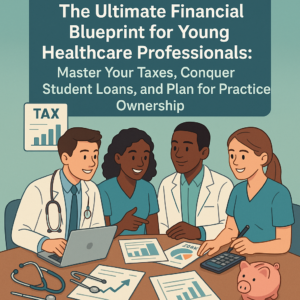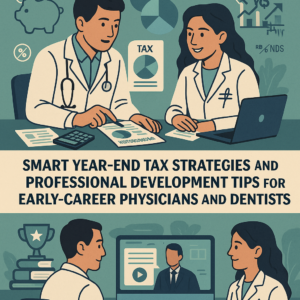7 Financial Strategies for Early-Career Healthcare Professionals
Embarking on a medical or dental career is an exciting milestone, but the financial landscape you inherit can feel complex. From managing student loans to planning for private practice growth, early-career physicians and dentists face unique challenges. At Mainstay Capital, we’ve guided healthcare professionals through these critical years. In this comprehensive guide, you’ll discover seven practical strategies—rooted in real-world experience—to align your vision, stabilize cash flow, and set a sustainable path for long-term success.
1. Clarify Your Vision and Core Values
Before diving into spreadsheets or investment products, take a moment for self-reflection. What motivates you? Family stability, community impact, early retirement, or philanthropic goals might top your list. Aligning financial planning with your personal and professional values ensures every decision supports your larger mission.
Why Values-Driven Planning Matters
- Provides clear direction for budgeting, saving, and investing.
- Helps set realistic expectations for practice ownership or partnership.
- Minimizes decision fatigue when facing unexpected financial challenges.
Action Steps
- Host a vision-setting session: Write down your top five personal and professional objectives.
- Rank values by urgency: Consider what matters most in the next 1, 5, and 10 years.
- Document a preliminary “Financial Mission Statement” to guide all future plans.
2. Build a Robust Cash Flow and Budget Plan
Effective cash flow management is the bedrock of financial stability for early-career healthcare professionals. Whether you’re earning your first attending salary or billing patients in private practice, understanding inflows and outflows will empower smarter decisions.
Key Components of a Healthcare Professional Budget
- Fixed Expenses: Rent or mortgage, insurance premiums, loan payments.
- Variable Expenses: Continuing education, medical equipment, travel.
- Deferred Goals: Emergency fund accumulation, retirement contributions.
Tools and Techniques
- Adopt specialized budgeting software tailored to physicians and dentists.
- Schedule a quarterly “finance check-in” to adjust projections after seasonality or practice growth.
- Automate savings: Allocate a portion of every deposit to emergency reserves and retirement accounts.
For an in-depth walkthrough of our cash flow process, visit our Our Process page.
Compliance note: All recommendations are illustrative. Your results may vary based on individual circumstances. Past performance does not guarantee future returns.
3. Tackle Student Loans and Debt Strategically
Medical and dental school debts often eclipse six figures. While income-driven repayment or refinancing can offer relief, a tailored strategy will minimize total interest and help you reach financial independence sooner.
Debt-Reduction Strategies
- Evaluate Repayment Options: Public Service Loan Forgiveness, income-driven plans, hybrid strategies.
- Refinancing Considerations: Look for competitive rates, flexible terms, and potential tax deductions.
- Snowball vs. Avalanche: Choose a payoff method that aligns with your psychological and financial goals.
Professional Tax Planning
- Maximize above-the-line deductions for student loan interest.
- Structure your professional entity—LLC or S-corp—for optimal tax efficiency.
- Plan charitable giving and retirement contributions to reduce taxable income.
Your debt payoff timeline should sync with personal goals—starting a family, purchasing a home, or opening a practice. For guidance on entity structuring and tax-smart strategies, explore our Services.
Compliance note: Mainstay Capital does not provide legal advice. Consult a professional advisor before implementing legal strategies.
4. Finance Your Private Practice or Partnership Entry
Transitioning from employee to practice owner or equity partner brings both freedom and financial risk. Structured planning around financing, overhead, and growth milestones is essential to avoid cash crunches.
Financing Options
- Conventional Bank Loans: Industry-specific lenders often offer favorable terms for healthcare professionals.
- Equipment Leasing: Preserve capital by leasing high-cost diagnostic or dental equipment.
- Physician-Specific Programs: Investigate association-based loan forgiveness or low-interest credit lines.
Controlling Overhead and Scalability
- Leverage technology to automate patient billing and appointment scheduling.
- Adopt a lean staffing model early; cross-train staff to handle multiple functions.
- Implement scalable workflows that allow adding providers without exponential cost increases.
For a blueprint on practice financing and scalable infrastructure, learn more via our Services offerings.
Compliance note: Investment strategies involve risk. There is no guarantee that any investment or strategy will be suitable or profitable.
5. Plan for Sustainable Growth and Succession
As your practice matures, shifting responsibilities to associates or partners becomes vital. Thoughtful succession planning ensures client continuity and preserves the firm’s legacy.
Developing Your Team
- Create clear career pathways and compensation models for emerging providers.
- Implement regular performance reviews and a structured feedback loop.
- Offer mentorship programs to transfer client relationships smoothly.
Succession Roadmap
- Draft a multi-phase transition timeline: from first referral handoff to full autonomy.
- Establish governance policies and decision-making protocols.
- Handle equity transitions with clear valuation metrics and buy-sell agreements.
Curious about our approach? Visit the About Us page to see our team’s background in guiding practice transitions.
6. Balance Personal Milestones with Financial Goals
Your life outside the clinic—family, health, hobbies—should thrive alongside your financial plan. Overcommitment can erode both your well-being and your bottom line.
Integrating Personal and Professional Plans
- Create a “life calendar” marking events like weddings, children, or sabbaticals.
- Allocate savings and insurance coverage—disability, life, health—to protect loved ones.
- Set aside time and budget for self-care and continuing education.
Wellness and Financial Therapy
- Consider financial coaching or therapy to align mindset and money behaviors.
- Track non-financial metrics—sleep, exercise, stress levels—to optimize performance.
- Reassess your vision periodically to avoid burnout and maintain fulfillment.
7. Next Steps: Build Your Customized Financial Roadmap
Implementing these seven strategies will position you for sustained success—both financially and personally. Whether you’re an attending physician, a newly minted dentist, or a practice partner, our team at Mainstay Capital is ready to guide you every step of the way. Visit our Our Process page to schedule a complimentary discovery call and begin crafting a plan tailored to your unique goals.
Thank you for trusting us as your fiduciary partner. We look forward to supporting your journey from early-career ambitions to enduring freedom and impact.






